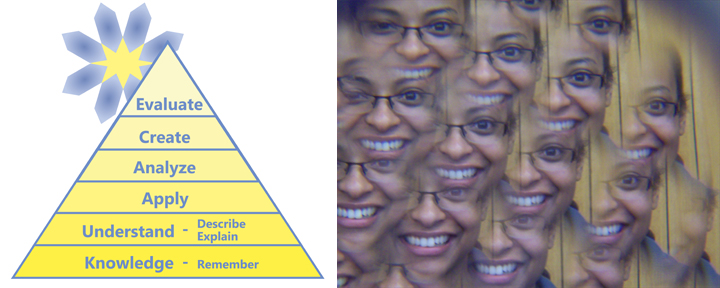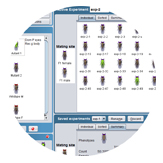Back to Group Meetings Archive List
 Dr. Ishara Mills-Henry
Dr. Ishara Mills-Henry
Group Meeting Date & Time: Thursday, April 7, 2011 @ 1:00 pm
Location: MIT 68-121
View the slides presented by Ishara.
Dr. Ishara Mills-Henry is the Program Director of “Science of the Eye”, a STEM education program funded by the National Eye Institute and based in Professor Jonathan King’s laboratory in the MIT Department of Biology. Her work helps to support high school biology teachers in their efforts to provide high quality, engaging, and inspiring science education about vision and the eye through delivery of inquiry-based, hands-on instruction.

Left: Colleagues interested in science education. Center: Dr. Ishara Mills-Henry discusses the "Science of the Eye" Program. Right: HHMI Professor Graham Walker addresses participants. Photos by Jeff Merriman.
In the Education Group Meeting on April 7th, Ishara spoke about how the “Science of the Eye” program grew out of the Massachusetts Darwin Bicentennial Project, which was directed by MIT Professor Jonathan King and has continued into the present as the Massachusetts Darwin Society. In 2009, this project organized visits by professional scientists to classrooms, assemblies, and other local educational fora. Driven by her commitment to support science education, Ishara was one of the scientists who volunteered time to the Darwin Bicentennial Project, for which she developed and led several activities about eye and vision evolution. Ishara and Professor King were delighted at the tremendous community interest in vision and eye evolution that they encountered. Thus, along with Outreach Coordinator Lisa Guisbond, they set out to build the “Science of the Eye” program.
Ishara and her colleagues have developed and implemented some fantastic activities, including a popular feature at the Cambridge Science Festival: a maze that visitors tried to navigate while wearing goggles that mimicked the effects of eye diseases, such as macular degeneration or retinitis pigmentosa, or insect vision!
In addition to supporting activities for students, the “Science of the Eye” program has a strong focus on professional development for teachers. In the program’s teacher development workshops, participating teachers first encounter an activity in the same manner that it could be presented to students, so that the teachers are provided with an example of how an activity might be conducted in their own classrooms. Ishara emphasized the importance of communicating to teachers the rationales and educational philosophies underlying preferred implementation methods. She also commented on the utility of a reflection component, included in these workshops, that encourages teachers to think ahead about any challenges that they might face when implementing a particular activity in their own educational settings. Ishara referred to Bloom’s Taxonomy in her discussion about “teaching teachers”, pointing out the importance of supporting teacher development through all levels of Bloom’s hierarchy of learning outcomes, since teachers will be creating new lessons and evaluating student learning.

Left: Ishara referenced Bloom's Taxonomy of Learning Outcomes and how it applies to her work. Right: Dr. Ishara Mills-Henry, as viewed by an insect.
Ishara received her Ph.D. in Biochemistry from MIT in 2007 for her doctoral work on the properties of the crystallin proteins found in the human eye. She continued her training as a postdoctoral fellow in the laboratory of John Dowling at Harvard University, researching the development of rod photoreceptors. In addition to her work with “Science of the Eye”, Ishara is also a postdoctoral fellow at TERC researching inquiry-based initiatives in science education.



